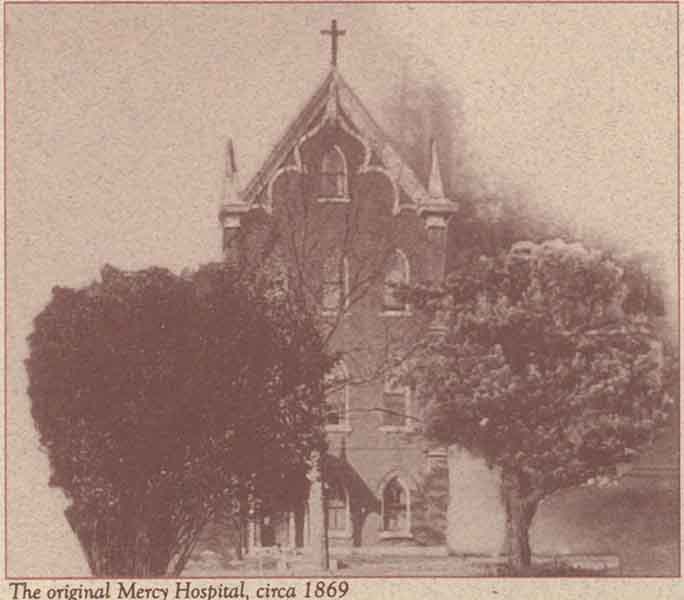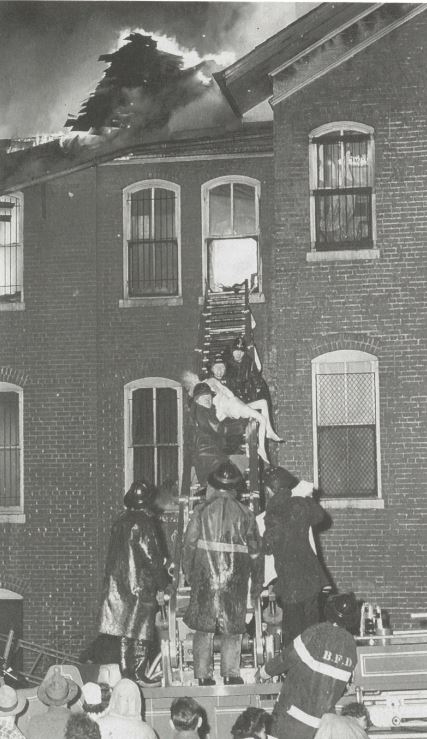Our MercyOne Genesis Story
In 1869, the Sisters of Mercy arrive in Davenport to raise money for a girl's school in DeWitt, Iowa. While visiting Davenport, one of the Sisters of Mercy, Mother Borromeo, is given a tour of the Scott County Poor Farm and witnesses notorious conditions there. One of the vows of the Sisters of Mercy is to "care for the poor, sick and indigent." Based on the community need, they abandon their plan for a school and start Mercy Hospital in Davenport instead. The Sisters of Mercy welcome their first patient to Mercy Hospital that same year and become the third hospital established west of the Mississippi River. 
Three years later, in 1972, a four-story hospital building opens at Mercy and is named St. Elizabeth’s after Mother Borromeo’s birth name. St. Elizabeth’s begins treating women with mental illness.
During the summer of 1873, Davenport experiences a Cholera outbreak leaving over 100 dead. The sisters of Mercy assist the Board of Health in taking care of patients, filling a 250 bed emergency hospital located in a downtown warehouse.
In 1874, Mother Borromeo, founder of Mercy Hospital, dies of cancer at 42. She is buried in a cemetery on the hospital grounds and later a chapel is built on her grave site.
The first documented appendectomy in the United States occurs at Mercy Hospital in 1883. The following year, in 1884, St. John’s Hospital for Mentally Ill Men opens on Mercy Campus.
Years later, the need for a hospital closer to downtown arises, leading to St. Luke’s opening in 1895 at 8th and Main streets. Also in 1895, nursing training begins at St. Luke’s and Mercy.
In 1918, St. Luke’s becomes a charter member of the American Hospital Association (AHA). The following year, construction on the new St. Luke’s Hospital is completed and operations move to Rusholme and Bridge streets.
Mercy hospital receives accreditation from the American College of Surgeons (ACS) in 1924. And almost 10 years later, on March 19, 1932, a new wing of Mercy with 150 addition beds, a new surgery, x-ray, laboratory and a pediatric unit opens and is dedicated by Bishop Rohlman.
_______
The deadly fire of St. Elizabeth’s
1950 - January 7 - Massive, Deadly Fire Engulfs St. Elizabeth's
 In the early morning of January 7, 1950, the 47 Sisters of Mercy are awakened by the cries of “Help, we’re on fire!” Nearby, St. Elizabeth’s Hospital for women with mental illness is engulfed in flames.
In the early morning of January 7, 1950, the 47 Sisters of Mercy are awakened by the cries of “Help, we’re on fire!” Nearby, St. Elizabeth’s Hospital for women with mental illness is engulfed in flames.
St. Elizabeth’s residents are trapped behind barred windows in the rapidly spreading inferno, making exits inaccessible. There is no sprinkler system, and only one exterior fire escape, but locked doors block the route out of the building. Firefighters save 25 women by breaking through walls and barred windows. 41 women die.
After the fire, both St. Elizabeth’s and St. John’s Hospital for men with mental illness are closed. The event, one of the deadliest tragedies in Iowa history, leads to improved building codes at the state and national levels. Decades later, MercyOne Genesis continues to remember the victims with a focus on safety for patients and employees.
______
In 1951, Mercy School of Nursing becomes St. Ambrose College Division of Nursing.
Mercy celebrates 100th anniversary in 1969 and a year later St. Luke’s celebrates 75 years of dedicated service. 
In 1973, the first merger proposal between Mercy and St. Luke’s is considered, however, community pressure derails plans. Then Mercy announces plans to build a new hospital and breaks ground in 1978.
In 1982, St. Luke’s unveils a newly updated and renovated facilities with fewer patient beds and more space for outpatient services.
20 years after the first merger proposal, in 1993, boards of Mercy and St. Lukes announce their plan to affiliate.
June 1, 1994, the consolation of Mercy and St. Luke’s is finalized and officially renamed Genesis Health System. Leo Bressanelli becomes the first CEO and President of Genesis.
Two years later, in 1996, Illini Hospital in Silvis, Illnois joins Genesis, creating the region’s first bi-state health system. And in 1997, Dewitt Community Hospital (est. 1952) affiliates with Genesis. River Valley Healthcare also joins Genesis, vastly broadening their physician network in 2001. That same year, the Genesis Heart Institute officially opens.
In 2005, Genesis Medical Center receives Magnet Designation for nursing excellence.
Genesis and St. Ambrose University break ground for a health sciences building on the GMC-West Central Park campus in 2009. Genesis donates $3 million and land for the project, including a $1 million gift from the Genesis Foundation to establish a nursing simulation lab.
Jackson County Public Hospital (est. 1949) in Maquoketa, enters in to a management agreement with Genesis in 2010.
In 2012, Genesis announces plans for Genesis HealthPlex, Moline. The building opens in 2013. Also in 2013, Genesis acquires Mercer County Hospital and announces a $12 million renovation project for the facility.
In 2014, Genesis becomes the first health system in the state to earn the Gold-level Iowa Recognition for Performance Excellence Award, the highest award for quality a company can earn in Iowa.
Genesis celebrates its 150th anniversary in 2019, honoring a long tradition of caring and service to the community.
March 1, 2023, Genesis Health System join MercyOne, a statewide Iowa health system. And in 2024, Genesis officially rebrands as MercyOne Genesis.
